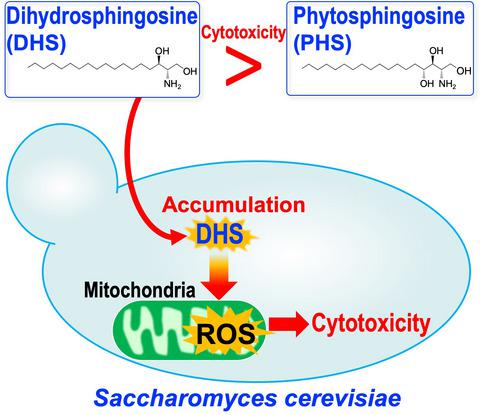Our official English website, www.x-mol.net, welcomes your
feedback! (Note: you will need to create a separate account there.)
Mitochondrial reactive oxygen species-mediated cytotoxicity of intracellularly accumulated dihydrosphingosine in the yeast Saccharomyces cerevisiae.
The FEBS Journal ( IF 5.5 ) Pub Date : 2020-01-15 , DOI: 10.1111/febs.15211 Nobuaki Arita 1 , Risa Sakamoto 1 , Motohiro Tani 1
The FEBS Journal ( IF 5.5 ) Pub Date : 2020-01-15 , DOI: 10.1111/febs.15211 Nobuaki Arita 1 , Risa Sakamoto 1 , Motohiro Tani 1
Affiliation

|
In eukaryotic cells, the content of sphingoid long‐chain bases (LCBs) is generally much lower than that of complex sphingolipids and ceramides, and the quantitative balance of these metabolites in cells is tightly regulated. In the budding yeast Saccharomyces cerevisiae, it has been demonstrated that exogenously added phytosphingosine (PHS) causes a strong growth defect in tryptophan auxotrophic cells, due to delayed uptake of tryptophan from the culture medium; however, the growth inhibitory effect of dihydrosphingosine (DHS) is less than that of PHS in tryptophan auxotrophic cells. Here, we found that, in tryptophan‐prototrophic yeast cells, exogenously added DHS is much more toxic than PHS. Exogenously added DHS is converted to PHS, Cers, or LCB 1‐phosphates through the action of sphingolipid C4‐hydroxylase, Cer synthases, or LCB kinases, respectively; however, suppression of further metabolism of DHS in cells resulted in an increase in the growth inhibitory activity of exogenously added DHS, indicating that DHS itself is causative of the cytotoxicity. The cytotoxicity of DHS was not mediated by Pkh1/2, Sch9, and Ypk1/2 kinases, intracellular targets of LCBs. DHS treatment caused an increase in mitochondria‐derived reactive oxygen species, and the cytotoxic effect of DHS was suppressed by depletion of mitochondrial DNA or antioxidant N‐acetylcysteine, but enhanced by deletion of SOD1 and SOD2 encoding superoxide dismutases. Thus, collectively, these results indicated that intracellularly accumulated DHS has mitochondrial reactive oxygen species‐mediated cytotoxic activity, which is much more potent than that of PHS.
中文翻译:

酵母酿酒酵母中细胞内积累的二氢鞘氨醇的线粒体活性氧介导的细胞毒性。
在真核细胞中,鞘氨醇长链碱基(LCB)的含量通常比复杂的鞘脂和神经酰胺的含量低得多,并且这些代谢产物在细胞中的定量平衡受到严格调节。在发芽酵母中酿酒酵母,已经证明,由于从培养基中延迟摄取色氨酸,外源添加的植物鞘氨醇(PHS)会导致色氨酸营养缺陷型细胞产生强烈的生长缺陷。然而,在色氨酸营养缺陷型细胞中,二氢鞘氨醇(DHS)的生长抑制作用小于PHS。在这里,我们发现,在色氨酸原养型酵母细胞中,外源添加的DHS比PHS毒性更大。外源添加的DHS通过鞘脂C4-羟化酶,Cer合酶或LCB激酶的作用分别转化为PHS,Cers或LCB 1-磷酸;然而,抑制细胞中DHS的进一步代谢导致外源添加DHS的生长抑制活性增加,表明DHS本身是细胞毒性的诱因。DHS的细胞毒性不是由Pkh1 / 2,Sch9,和Ypk1 / 2激酶,LCB的细胞内靶标。DHS处理导致线粒体来源的活性氧增加,DHS的细胞毒性作用被线粒体DNA或抗氧化剂的消耗所抑制N-乙酰半胱氨酸,但通过缺失SOD1和SOD2编码超氧化物歧化酶而增强。因此,总的来说,这些结果表明,细胞内积累的DHS具有线粒体活性氧介导的细胞毒性活性,其效力远高于PHS。
更新日期:2020-01-15
中文翻译:

酵母酿酒酵母中细胞内积累的二氢鞘氨醇的线粒体活性氧介导的细胞毒性。
在真核细胞中,鞘氨醇长链碱基(LCB)的含量通常比复杂的鞘脂和神经酰胺的含量低得多,并且这些代谢产物在细胞中的定量平衡受到严格调节。在发芽酵母中酿酒酵母,已经证明,由于从培养基中延迟摄取色氨酸,外源添加的植物鞘氨醇(PHS)会导致色氨酸营养缺陷型细胞产生强烈的生长缺陷。然而,在色氨酸营养缺陷型细胞中,二氢鞘氨醇(DHS)的生长抑制作用小于PHS。在这里,我们发现,在色氨酸原养型酵母细胞中,外源添加的DHS比PHS毒性更大。外源添加的DHS通过鞘脂C4-羟化酶,Cer合酶或LCB激酶的作用分别转化为PHS,Cers或LCB 1-磷酸;然而,抑制细胞中DHS的进一步代谢导致外源添加DHS的生长抑制活性增加,表明DHS本身是细胞毒性的诱因。DHS的细胞毒性不是由Pkh1 / 2,Sch9,和Ypk1 / 2激酶,LCB的细胞内靶标。DHS处理导致线粒体来源的活性氧增加,DHS的细胞毒性作用被线粒体DNA或抗氧化剂的消耗所抑制N-乙酰半胱氨酸,但通过缺失SOD1和SOD2编码超氧化物歧化酶而增强。因此,总的来说,这些结果表明,细胞内积累的DHS具有线粒体活性氧介导的细胞毒性活性,其效力远高于PHS。









































 京公网安备 11010802027423号
京公网安备 11010802027423号